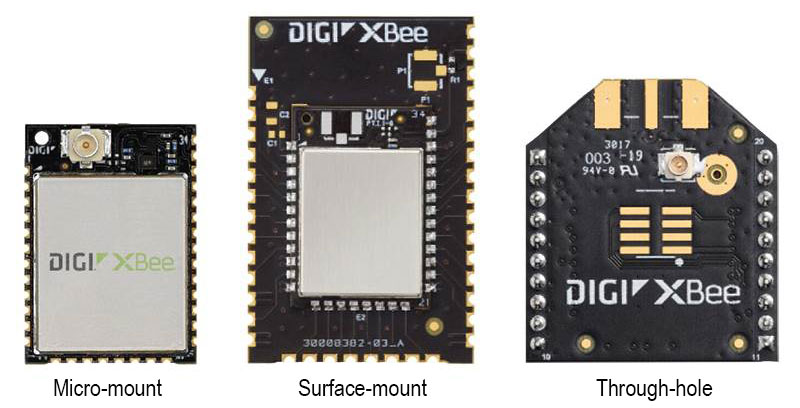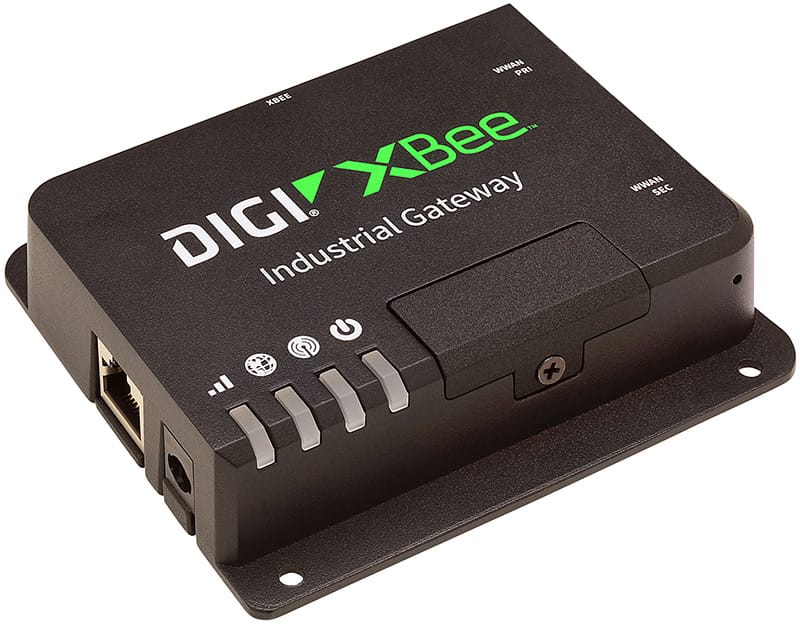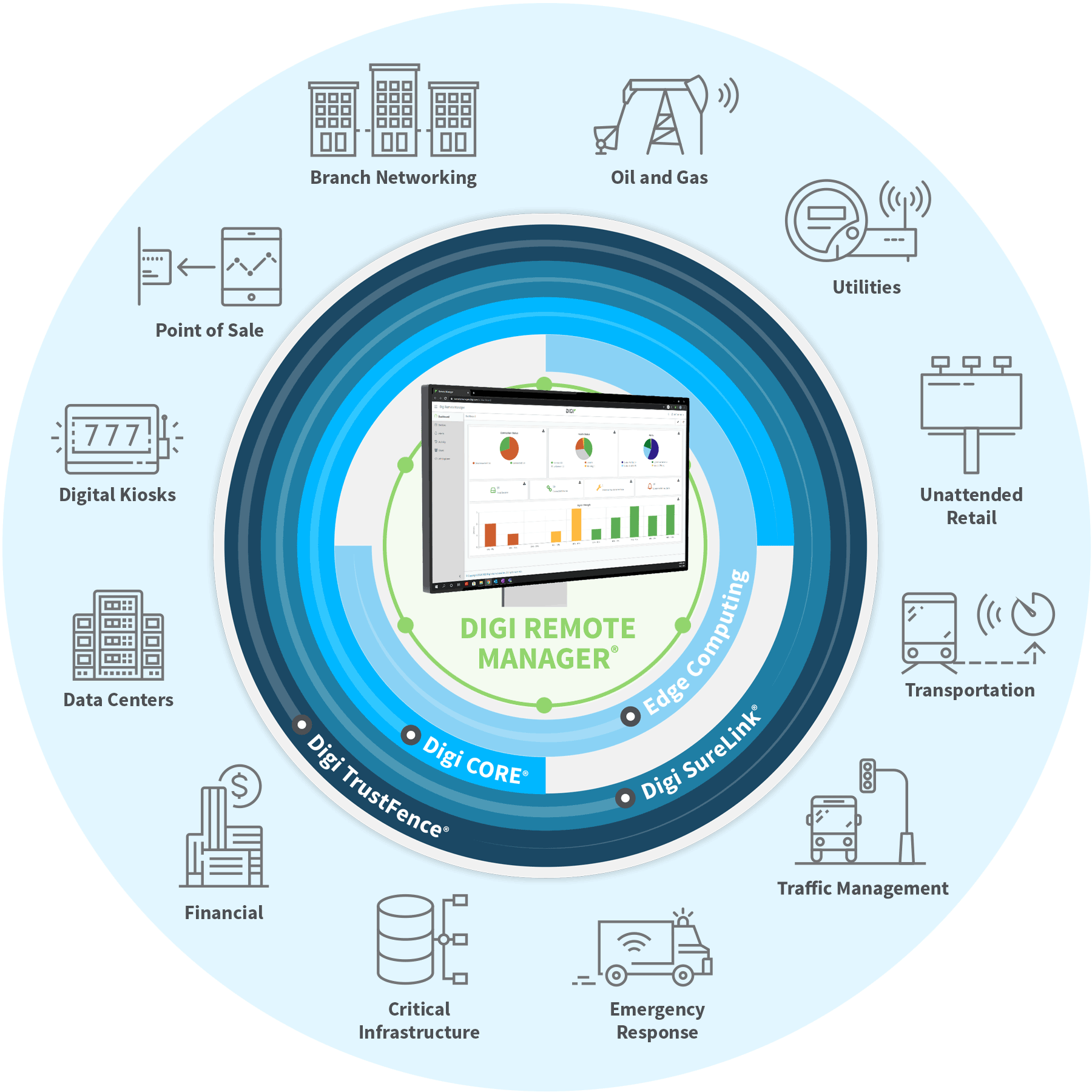Continuing the 20+ year legacy of sub-GHz RF modules, Digi has launched the Digi XBee® XR family of long-range modules, including
Digi XBee XR 900 — which is pre-certified for multiple regions — and
Digi XBee XR 868 — which is pre-certified for applications in the European region.
These advanced RF modules are designed for long-range and interference-resistant wireless communication. They operate across various sub-GHz frequencies, such as the 902-928 MHz band in the United States and 868 MHz in Europe. Australia, New Zealand, Japan and South Korea are also supported on the XR 900 platform. They are based on Silicon Labs' EFR32 microcontroller and feature SAW filters to ensure optimal performance even in noisy environments.

Trifecta of XBee Form Factors – MMT, SMT, TH
The Digi XBee XR family is available in the three XBee form factors, tailored for flexibility in design and application: Micro-mount (MMT), surface-mount (SMT) and through-hole (TH).
Each of these has unique advantages for embedded design.
- TH — The through-hole form factor is great for prototyping, with many different interface board options available from providers such as Sparkfun and Parallax, as well as the XBIB-C Board from Digi. No soldering is required, making it easy to plug the module directly into breadboards or development boards.
- SMT — The surface-mount form factor is compact and low-profile for space-constrained applications, and soldered down for a durable connection, which is important for vibration and industrial or mobile applications. Interface boards are also available for easy testing.
- MMT — The micro-mount form factor is a highly compact version of the XBee module. It is designed for applications requiring small size, lightweight designs, and low-power operation.
Digi XBee XR Capabilities
Here are some key highlights of the XBee XR family.
- Interference resistance: Utilizing Frequency Hopping Spread Spectrum (FHSS) makes the XBee XR family less susceptible to interference from fixed-frequency devices or narrowband noise sources. An integrated SAW filter supports optimal performance in noisy RF environments. Additional feature enhancements include Frequency Agility and Listen-Before-Talk.
- Security: Digi XBee XR modules are equipped with 256-bit AES encryption for secure data transmission.
- Networking capabilities: The product line supports DigiMesh®, a reliable peer-to-peer networking protocol.
- Ease of use: Setup and configuration are simple, via Digi XBee Studio software.
- Fully certified: Digi XBee XR 900 is pre-certified for use in 900 MHz unlicensed band, while Digi XBee 868 is pre-certified for use in the 863 to 870 MHz range.
- Industrial temperature range: −40 °C to 85 °C (−40 °F to 185 °F) make Digi XBee XR an excellent choice for applications in challenging environments.
Sub-GHz RF Module Performance
Performance of an RF module is often measured by distance achieved between two devices, but there are other key metrics for performance. These parameters help engineers assess the module's performance in wireless communication applications across various environmental conditions.
- Receiver sensitivity: Measured in dBm, receiver sensitivity indicates the weakest signal the module can detect and successfully decode. Lower values (more negative) mean better sensitivity.
- Transmit power: Measured in dBm, transmit power represents the output power of the radio transmission. Higher values indicate stronger signal strength.
- Range/link budget: This parameter quantifies maximum communication distance based on transmission power, receiver sensitivity, antenna gain, and environmental factors.
- Modulation efficiency: Evaluates data transmission quality and bandwidth utilization using metrics like Symbol Rate and Modulation Scheme (e.g., GFSK, FSK).
- Power consumption: This is measured in milliwatts during transmit, receive, and sleep modes. Power management is critical for battery-powered wireless devices.
IoT Gateway – Coming Soon
 A gateway within an IoT deployment converts data from local wireless protocols (such as Zigbee, DigiMesh®, or LoRaWAN®) into an IP network via cellular, Wi-Fi or Ethernet. Operating as a network bridge, it connects enterprise LANs to the Internet while enabling different network protocols to communicate with IP or cellular networks.
A gateway within an IoT deployment converts data from local wireless protocols (such as Zigbee, DigiMesh®, or LoRaWAN®) into an IP network via cellular, Wi-Fi or Ethernet. Operating as a network bridge, it connects enterprise LANs to the Internet while enabling different network protocols to communicate with IP or cellular networks.
Beyond basic connectivity, these gateways can also perform edge computing functions; they aggregate incoming data streams, handle analog-to-digital conversion, and apply encryption before sending data across the network.
Digi continues to innovate on the IoT gateway side of the solution. Keep an eye out for an updated IoT Gateway from Digi coming soon.
Cloud Management Platform
 IoT device management has evolved from a convenience into a fundamental operational requirement. Modern connected devices now combine advanced processing power, rich functionality, and edge computing capabilities to serve as the sensory and communications backbone of your application infrastructure. This complexity demands comprehensive remote management tools that seamlessly integrate with your network architecture. Such solutions must automate key processes, monitor network-wide device activity, and provide granular control, allowing both batch and individual device management for software updates, security patches, troubleshooting, and maintenance tasks.
IoT device management has evolved from a convenience into a fundamental operational requirement. Modern connected devices now combine advanced processing power, rich functionality, and edge computing capabilities to serve as the sensory and communications backbone of your application infrastructure. This complexity demands comprehensive remote management tools that seamlessly integrate with your network architecture. Such solutions must automate key processes, monitor network-wide device activity, and provide granular control, allowing both batch and individual device management for software updates, security patches, troubleshooting, and maintenance tasks.
Digi Remote Manager® (Digi RM) elevates network management by transforming distributed IoT devices into a cohesive, intelligent system. The platform streamlines the administration of vast device networks, enabling centralized control over thousands of mission-critical endpoints through a unified command interface. From any desktop or mobile device, administrators can perform essential tasks including device activation, diagnostics, configuration management, firmware updates, and automated maintenance scheduling. This comprehensive control transforms complex network management into a streamlined, efficient operation.
Digi XBee XR Use Cases
The XBee sub-GHz product line supports several key applications:
1. Industrial Monitoring and Control
 Digi XBee XR supports wireless communications in industrial monitoring and control applications, enabling real-time data transmission, remote operation, and enhanced system flexibility. Using a range of network protocols, these systems connect sensors, controllers, and other devices across a wide area network, and provide visibility into equipment and device health for predictive maintenance. Use cases include:
Digi XBee XR supports wireless communications in industrial monitoring and control applications, enabling real-time data transmission, remote operation, and enhanced system flexibility. Using a range of network protocols, these systems connect sensors, controllers, and other devices across a wide area network, and provide visibility into equipment and device health for predictive maintenance. Use cases include:
- Factory automation systems
- Equipment monitoring and predictive maintenance
- Industrial sensor networks in harsh RF environments
- Process control systems where long range is needed
2. Agriculture/Environmental
 Digi XBee XR connects systems in the field in a range of applications including weather and soil monitoring in agricultural and environmental applications, enabling precise and real-time data collection. By deploying IoT sensors, farmers and environmentalists can monitor critical parameters such as soil moisture, temperature, humidity, and weather patterns. This data supports informed decision-making for irrigation, fertilization, and crop management. Use cases include:
Digi XBee XR connects systems in the field in a range of applications including weather and soil monitoring in agricultural and environmental applications, enabling precise and real-time data collection. By deploying IoT sensors, farmers and environmentalists can monitor critical parameters such as soil moisture, temperature, humidity, and weather patterns. This data supports informed decision-making for irrigation, fertilization, and crop management. Use cases include:
- Irrigation control systems
- Weather station monitoring
- Soil moisture sensing
- Greenhouse automation
- Livestock tracking
3. Energy Management
 Digi XBee XR supports energy management applications by enabling seamless connectivity for smart meter reading and remote utility monitoring, as well as real-time transmission of energy consumption data from smart meters to utility providers. This enables accurate billing, demand forecasting, and efficient grid management. Use cases include:
Digi XBee XR supports energy management applications by enabling seamless connectivity for smart meter reading and remote utility monitoring, as well as real-time transmission of energy consumption data from smart meters to utility providers. This enables accurate billing, demand forecasting, and efficient grid management. Use cases include:
- Smart meter reading
- Solar panel monitoring
- Power grid monitoring
- Energy consumption tracking
- Remote utility monitoring
4. Building Automation
 Digi XBee XR modules provide connectivity for modern building automation systems, enabling efficient monitoring and control of smart lighting, HVAC systems, and other infrastructure. These devices collect real-time data on occupancy, temperature, humidity, and energy usage, allowing systems to dynamically adjust lighting intensity, heating, cooling, and ventilation. This optimization improves energy efficiency and reduces operational costs. Use cases include:
Digi XBee XR modules provide connectivity for modern building automation systems, enabling efficient monitoring and control of smart lighting, HVAC systems, and other infrastructure. These devices collect real-time data on occupancy, temperature, humidity, and energy usage, allowing systems to dynamically adjust lighting intensity, heating, cooling, and ventilation. This optimization improves energy efficiency and reduces operational costs. Use cases include:
- HVAC control systems
- Lighting control
- Access control systems
- Security system sensors
- Building energy management
5. Remote Asset Monitoring
 Digi XBee XR enables remote asset monitoring for visibility and control over equipment, tanks, fleets, and other assets. These devices collect and transmit data on asset location, performance, usage, and conditions, enabling proactive maintenance and reducing downtime. For tanks, IoT sensors monitor levels, temperature, and pressure to optimize operations and prevent leaks or overflows. Fleet tracking systems powered by IoT improve route optimization, fuel efficiency, and safety. With real-time alerts and analytics, IoT enhances operational efficiency, reduces costs, and increases the lifespan of assets. Use cases include:
Digi XBee XR enables remote asset monitoring for visibility and control over equipment, tanks, fleets, and other assets. These devices collect and transmit data on asset location, performance, usage, and conditions, enabling proactive maintenance and reducing downtime. For tanks, IoT sensors monitor levels, temperature, and pressure to optimize operations and prevent leaks or overflows. Fleet tracking systems powered by IoT improve route optimization, fuel efficiency, and safety. With real-time alerts and analytics, IoT enhances operational efficiency, reduces costs, and increases the lifespan of assets. Use cases include:
- Tank level monitoring
- Equipment tracking
- Asset location services
- Remote site monitoring
- Fleet management
The sub-GHz frequency bands (particularly 900 MHz) are especially valuable in these applications because they provide these key capabilities:
- Provide better signal penetration through walls and obstacles
- Offer longer range compared to 2.4 GHz solutions
- Experience less interference from other wireless devices
- Work well in RF-challenging industrial environments
These characteristics make Digi’s XR family particularly suitable for applications requiring long-range communication in complex RF environments.
Next Steps